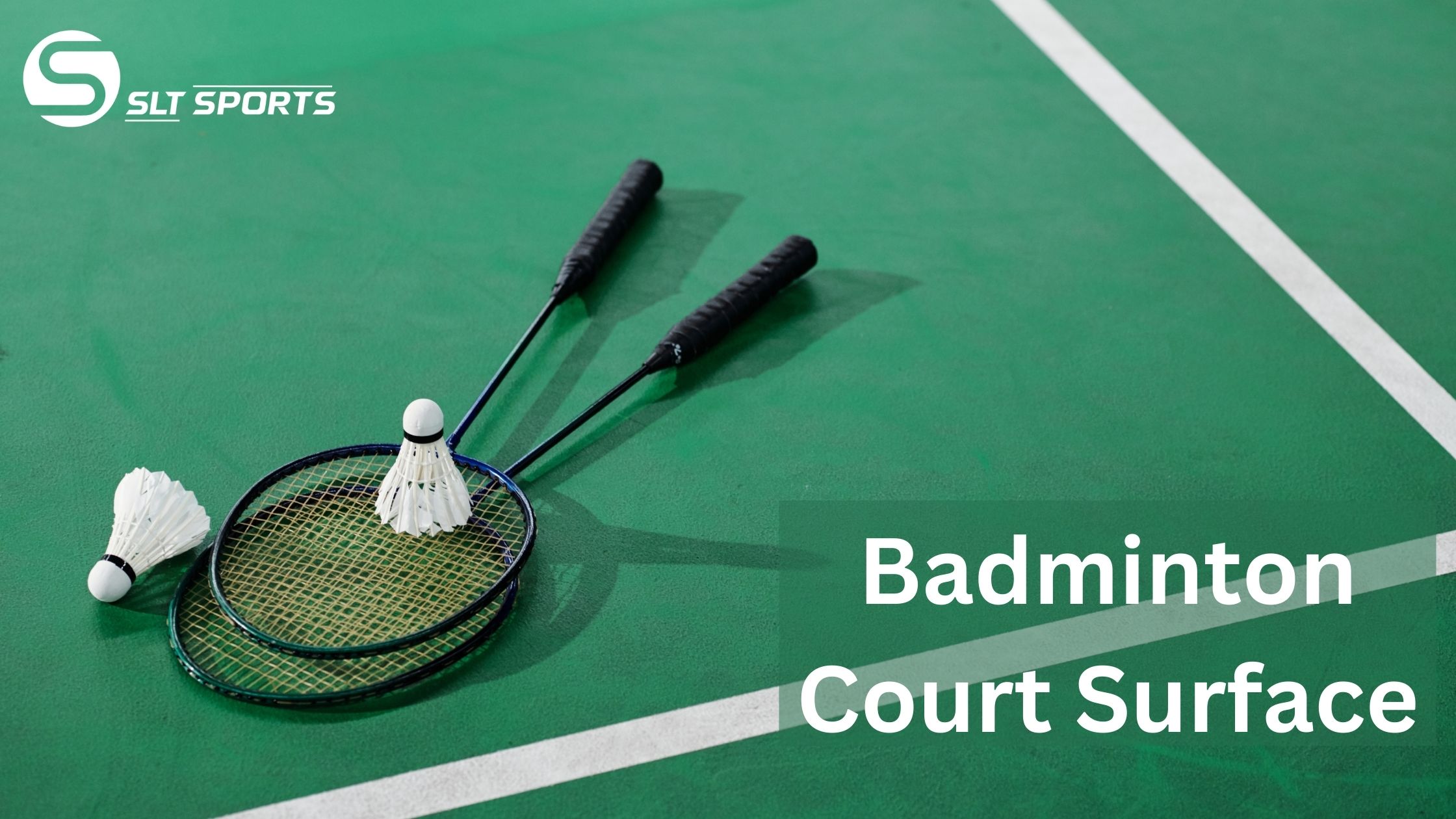
Badminton is one of the world’s most popular sports. The court surface plays a key role in player movement, speed, and injury prevention. One should make sure that badminton court flooring safety, durability and performance. The various surfaces that one can use differ in grip, shock absorption and durability. Some surfaces are for international tournaments, others for recreation and multipurpose sports facilities. This guide discusses the different types of badminton court surfaces, their pros and cons and will help you determine the best surface for you.
At SLT Sports, premium high-end sports surfaces are our forte, and we provide professional-level solutions to build a badminton court using the best materials and professional skills.
Types of Badminton Court Surfaces
1. Acrylic Flooring
Acrylic flooring is the most expansive surface material utilized for badminton courts, especially on outdoor badminton court construction. Consisting of multiple layers of acrylic coating on a concrete or asphalt substrate, it assures a smooth but non-sliper surface.
Pros:
- Weather resistant, good for outdoor courts
- Good grip and shock absorption
- Long lasting and easy to maintain
- Multi-sport use
Cons:
- Can be a bit hard on the joints compared to synthetic mats
- Requires resurfacing occasionally to maintain grip
Best for: Semi-pro courts, multi-purpose facilities, outdoor courts
At SLT Sports, we supply top end Acrylic court installations with certified materials, for professional grade surfaces for high performance play.
Synthetic Acrylic flooring
It is an alternative choice for wooden courts. These court floorings give excellent grip to both professional and amateur players.
Pros:
- It is affordable to buy and easy to install.
- Good grip and slip resistant Little maintenance
- Various thicknesses are available to suit different playing needs
Cons:
- Dissolve faster in high traffic areas
- Needs to be replaced sometimes
- Some low quality ones can get slippery after sometime
Best for outdoor training centers, recreational courts, multipurpose sports facilities
Concrete flooring (with coat paint or coating)
Concrete floors with a painted surface or synthetic coating are common for the recreational, or budget friendly badminton courts flooring. While cheap, these concrete flooring, however, lack the cushioning that suits the long-term comfort and protection of the player.
Pros:
- Highly durable and low maintenance
- Budget friendly compared to other flooring
- Suitable for outdoor courts and community centers
Cons:
- Hard on players joints, increases injury risk
- Can be slippery if surface is not maintained properly
Best for: Recreational and community courts, budget friendly setups
For budget friendly installations without compromising on durability, SLT Sports offers high quality flooring materials for long lasting performance.
Badminton Court Surface Factors to Consider
1. Player Comfort & Safety
Flooring should give proper cushioning to reduce impact on joints and minimize injuries. Sports synthetic acrylic surfaces are best in this regard, concrete is the least forgiving. High shock absorption means less strain on knees and ankles, so players can move quickly without discomfort.
2. Budget & Installation Cost
Badminton court flooring can cost a lot. Acrylic and synthetic surfaces follow, concrete is the most budget friendly but lacks player comfort and performance benefits. If you’re planning a long term investment, high quality surfaces like synthetic flooring are ideal, if budget constraint then acrylic or concrete may be the option. SLT Sports offers cost effective solutions as per your requirement.
3. Durability & Maintenance
Life of a badminton court surface depends on the material used. Acrylic and concrete courts are the most durable and need least maintenance, synthetic surfaces need frequent maintenance to keep them playable and looking good. synthetic flooring need to be replaced every few years depending on usage.
4. Indoor vs Outdoor Use
The kind of surface must be determined by whether the facility used is indoor and outdoor. Generally, some surfaces that will be used for indoor courts should better be synthetic flooring, as they are good grips and cushioned. Designed or made for outdoor are extremely weather-resistant materials that should include acrylic or concrete from exposure to rain or sunlight or high temperatures.
SLT Sports provides surface solutions for indoor and outdoor courts with certified materials.
5. Grip & Traction
Grip level of the surface affects a player’s speed, agility and chances of slipping. synthetic floors have good traction, that’s why they are preferred for professional play. Acrylic surfaces also have good grip but can wear down over time and need resurfacing. Concrete unless coated properly can be slippery and unsafe for fast movements.
6. Shock Absorption & Joint Impact
Shock absorption is important to prevent fatigue and long term injuries. synthetic surface have high shock absorption, reduces strain on player’s knees and ankles. Synthetic surfaces also have good cushioning, concrete courts have no shock absorption and can cause injuries over prolonged use.
Badminton Court Dimensions and Cost Considerations
Badminton Court Measurements and Budgeting
For planning a badminton court installation, it is essential to know the badminton court size and dimensions.
The BWF holds the standard badminton court measurement of 43 ft (13.4 m) in length and 20 ft (6.1 m) in width for doubles play, while for singles play, the width is 17 ft (5.18 m).
The shuttle court is clear of any obstructions around it for easy movement for players. In comparison, the dimensions are those of an indoor badminton court, but it is difficult for outdoor play because of the renovation setting control and advisement needs. The difference is that it should have a consistent surface for any weather difficulties. When looking for a badminton court near me, ensure the facilities offer a well-maintained surface.
Cost of Badminton Court and Installation:
Badminton court price varies according to the material and location. Here’s a rough estimate of the badminton court installation cost:
- Artificial Turf: ₹500 – ₹1,800 per sq. meter
- Synthetic (PVC vinyl flooring): ₹700 – ₹1,500 per sq. meter
- Acrylic flooring: ₹500 – ₹1,200
- Sports Interlocking Tiles: ₹600 – ₹1,500, per sq. meter
At SLT Sports, we provide high-quality, cost-effective installations of badminton courts with certified materials tailored to your budget and requirements.
Conclusion
The surface you choose for your badminton court should depend on your needs, budget, and location. Acrylic flooring with a synthetic mat is best for professional play. Synthetic flooring is considered the best synthetic surface option for indoor courts. Outdoor courts need to be made from tough, weatherproof surfaces such as acrylic or concrete, while recreational and budget models can use concrete flooring with a painted surface. If one wishes to invest in a badminton court, it is advisable to install the circuit base that ensures the highest performance level and will keep to a minimum injury hazards while prolonging playability. While building the badminton court, contact the professional installations for the best materials and services.
Do you need expert advice on choosing the right badminton court surface? Connect with SLT Sports & get high-quality sports flooring solutions tailored to meet your needs!
Frequently Asked Questions
Synthetic acrylic flooring is the best surface for badminton courts and provides superior shock absorption, grip, and player comfort.
Depending on the type of surface used, regular cleaning and resurfacing are a must. Sports interlocking tiles need frequent thorough cleaning, while synthetic and acrylic surfaces require clean-up sometimes to maintain good grip and durability.
Yes you can create, but ensure that the surface meets the required standards of grip and cushioning. Acrylic and synthetic floors are the best choice for multi-sport usage.

